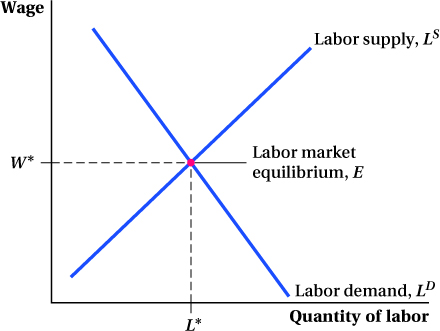13.3 Labor Market Equilibrium
The labor market reaches equilibrium when the wage equates the quantity of labor demanded by firms and the quantity of labor supplied by workers, as shown in Figure 13.7. LD is the market labor demand curve and LS is the market labor supply curve. The equilibrium wage is W* and the equilibrium quantity of labor is L*.
This market equilibrium relates to our analysis of labor demand at the firm level. Recall that the firm takes the wage as given and hires labor until its marginal revenue product of labor equals the market-

523
By definition of market equilibrium, the sum of all firms’ hiring when the wage is W* will be L*. In other words, if every firm hires up to the point where W* equals its MRPL—which generally varies across firms because they have different production functions, amounts of capital, and face different demands for their output markets—